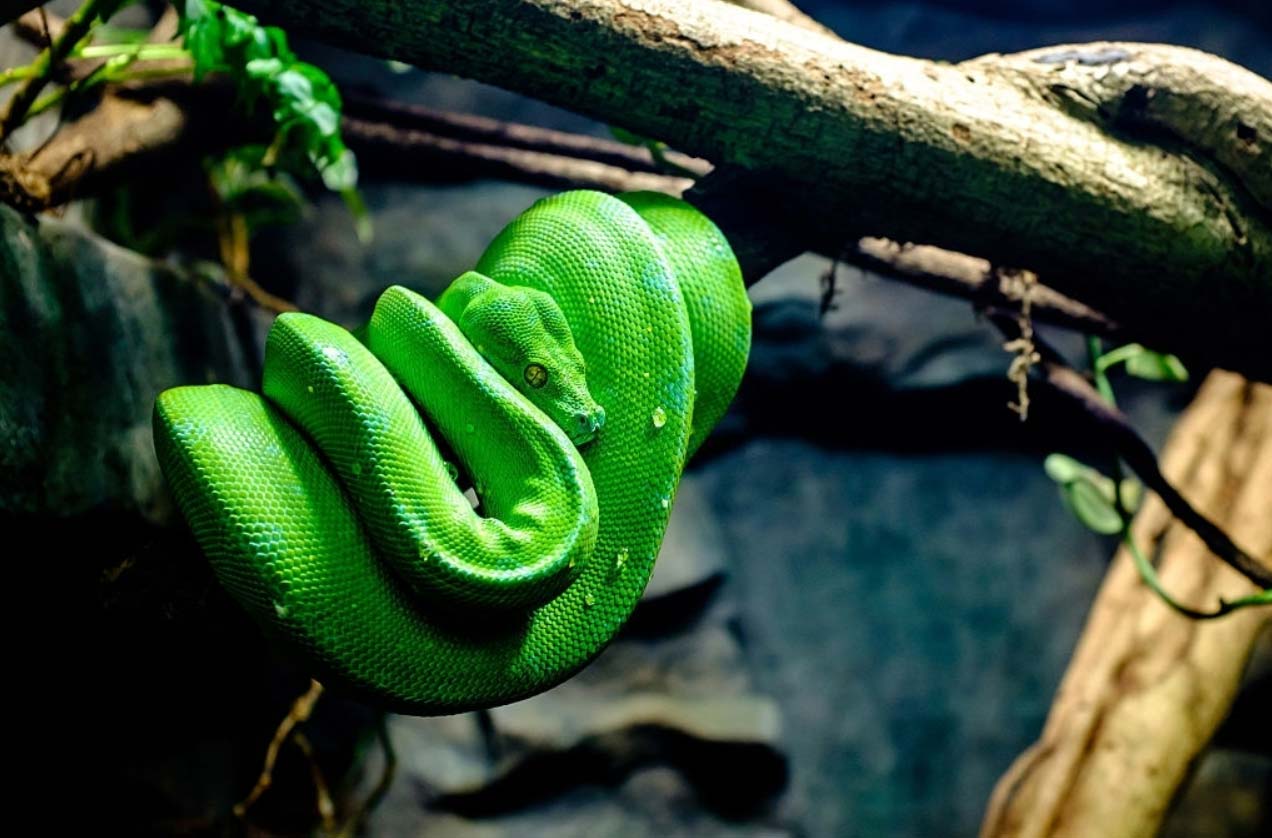Mostly green, sometimes yellow, often red, but also blue!
The green tree python (Morelia viridis) is a stunning reptile that has bright green skin with striking patterns and color morphs.
If you are in the market for one of these arboreal beauties, then you need to know a few important things.
Finding a captive breeder is key. Imported green tree pythons are aggressive and bite handlers.
Due to it being an arboreal constrictor snake, its 100+ teeth create deep cuts and tears in the skin. A bite from green tree python teeth is a painful one that can require medical intervention.
The green tree python is not a snake for frequent handling, it is shy and mostly nocturnal. Due to its outstanding and variable coloring, it makes a lovely display snake.
Buying a green tree python is a pricey endeavor. However, it is worth the money as these are hardy animals and will live long lives if they come from a reputable breeder and are taken care of properly.
Reptile Overview
| Common name: | Green tree python or green trees. Sometimes referred to as “Chondros” because of the original genus name: Chondropython. |
| Scientific name: | Morelia viridis |
| Indigenous: | Indonesian islands, Papua New Guinea, Australia (Cape York Peninsula) |
| Natural habitat: | Arboreal (Tropical Rain Forests) |
| Endangered status: | Least Concern. However, they are heavily targeted by poachers in the illegal pet trade. This makes their future unknown. |
| Experience level: | We would recommend a moderate amount of experience in snake-keeping before owning a green tree python. |
Behavior and Temperament of a Green Tree Python
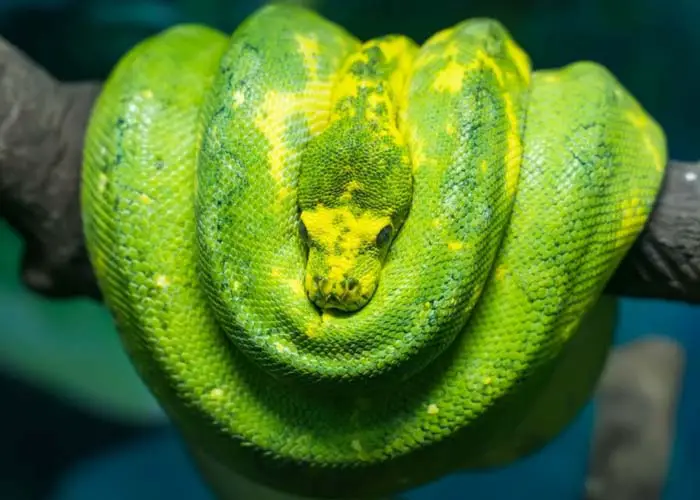
These snakes are often labeled as aggressive and snappy. This is true but also not true.
A careful distinction needs to be made:
- Wild, imported snakes are often aggressive and will bite handlers. This is because of the trauma that occurs during the capture of the snake. Illegally transporting green tree pythons is a difficult journey for the snake. Therefore, the snake has lived a very hostile and distressing life which makes it prone to aggressive behavior.
- Captive-bred snakes with established breeding lines and good care are even-tempered and can be docile creatures if handled correctly. Aggressive traits are bred out of the breeding lines. However, the Biak line tends to be more aggressive than the rest.
Green tree pythons have over 100 long, sharp, backward-pointing teeth designed to bite into prey and hang on.
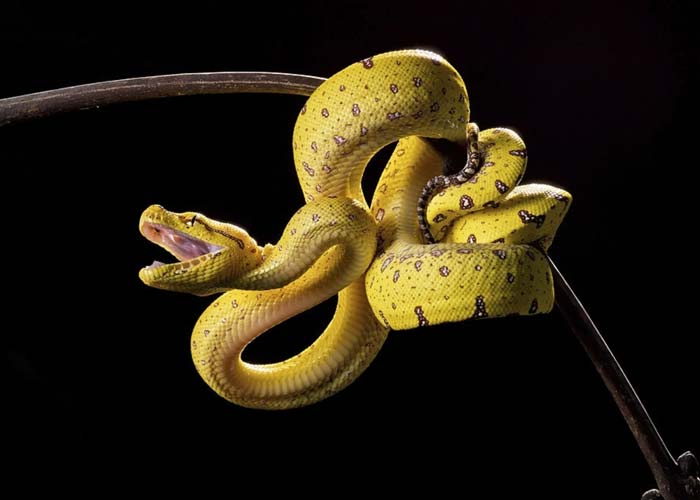
They are nonvenomous snakes, so their teeth are meant to hold onto prey while the snake suffocates it through constriction.
When humans are bitten by green tree python teeth, they will have deep lacerations that may require medical intervention.
Knowing where your snake comes from and the kind of temperament it has is a matter of your safety. Research your breeders well before buying your snake.
Lifespan of a Green Tree Python
A green tree python can live approximately 12 to 20 years depending on overall health and quality of care.
It is important to note that captive-bred snakes live longer than imported ones.
The imported snakes have undergone many distressing situations both in the wild and in the illegal pet trade.
They often come with diseases, infections, or are malnourished. This all shortens the snake’s lifespan.
Appearance of a Green Tree Python
Physical attributes
These snakes have a very large looking head in comparison to their bodies. Their heads are diamond-shaped. Like most pythons this gives them an aggressive or dog-like appearance – You decide!
Their bodies are slim and reach around 4-6 feet in length. At the end of their tails, they have a small hook called a caudal luring. This is wriggled in front of the snake’s face to look like a worm and attract prey.
Colors and patterns
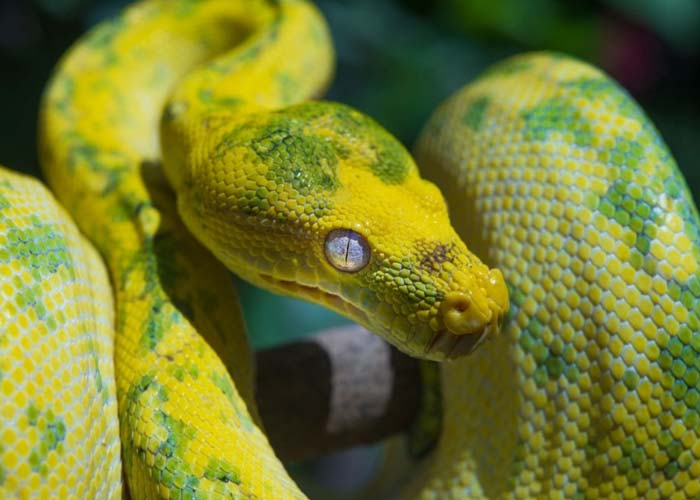
The green tree python varies in color. When they are born, the pythons are deep maroon, red, or yellow.
As they mature (about one year), they change color! This color change is called an ontogenetic change.
Be aware that if you are purchasing your snake for a specific morph and it is under three years of age, depending on the color it started, its color may continue to change.
Each python will have unique patterns on it as well as unique coloring.
Their coloring and patterning can be attributed to the different breeding lines which are based on the original location of the snake’s breeding line.
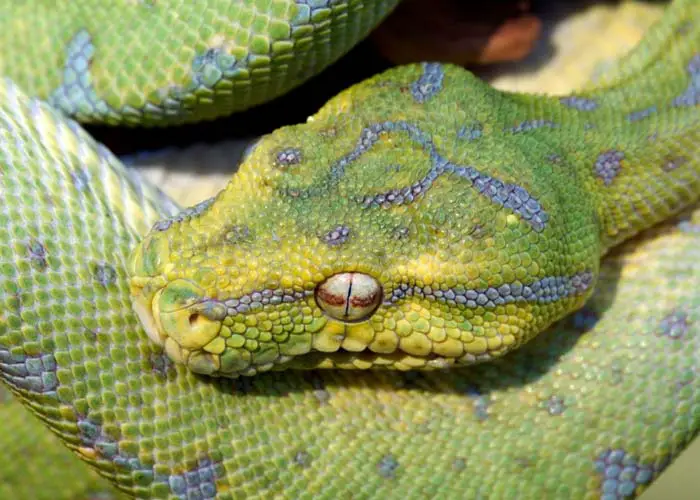
Exporting lines from Australia and Papua New Guinea is illegal. Listed here are the morphs from the Indonesian region:
- Sorong: Light green body. Blue spinal coloring. Blue triangles on the sides of the body. Black tail.
- Biak: Predominantly green with patches of yellow.
- Jayapura: Blue/green body. Blue stripe along the spine. Yellow or white scale clusters. Black tail.
- Aru: Bright green with blue patches. Some white scale clusters may also occur.
- Manokwari: Light green body. Blue patches. Individual white scales. Blue and black tail.
- Wamena: Green body. Dark green or yellow patches, occasionally outlined in blue, along the spine. Some Wamena morphs have black patches.
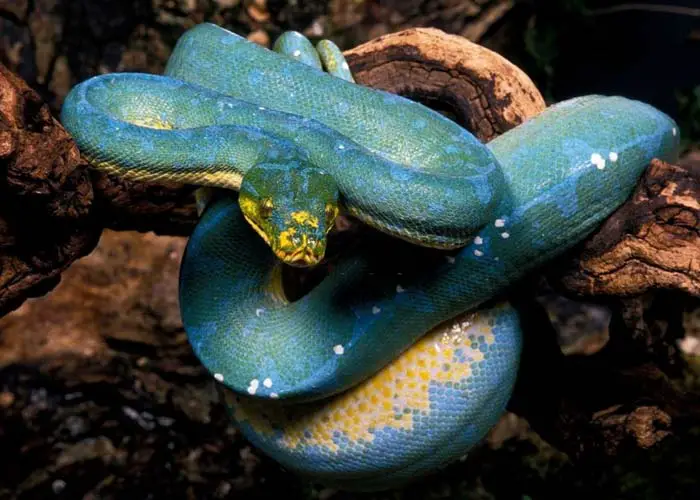
Some color variations have become common through cross-breeding the different morphs and selectively breeding for specific traits:
- High Blue: These snakes are predominantly blue in color. The blue ranges from teal to cornflower with some green. When purchasing a High Blue morph, do not rely on photos sent to you as they are easily edited to make the blue more striking. See the snake in person.
- High Yellow: These snakes are predominantly yellow with green speckling. The High Yellow morph is usually bred from the Biak line so be on the lookout for more aggressive behavior
- Melanistic/Mite Phase: These snakes have a lot of black coloring on them. The clusters of black scales can look like a mite infestation, hence the name. Black scales do not always last and can change to a lighter color after approximately five years.
- Albino: Albinism is a genetic defect that indicates a complete lack of melanin. These snakes are golden yellow in color with yellow eyes. They do not have a speck of green on them. These snakes may need additional care as albinism can cause skin issues if they are exposed to harsh UV lighting or the sun.
Breeding your green tree pythons for specific morphs is tricky and unpredictable. Rather enjoy the variations that you have than obsessively breed them for the “perfect” morph.
Enclosure Set Up for a Green Tree Python
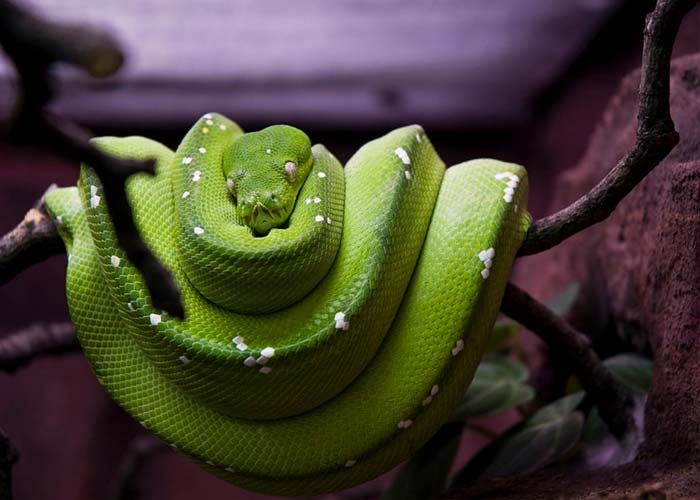
The green tree python’s natural habitat is the rain forest, so they require high humidity. This means that their enclosure needs to be able to withstand and maintain a humid environment.
If you are rearing your snake from a juvenile age the only change to our enclosure setup suggestions is size.
Young snakes get stressed in larger cages, use ones with a maximum volume of 10 gallons, so for juvenile green tree python we recommend 12 x 12 x 12 Exo Terra Glass Terrarium Kit.
Do not get an adult-sized setup, put a baby snake in and think it will simply grow into it. Human babies need cots, children need small beds, and adults have large ones. You would not put a toddler in a king-size, would you?
Wood enclosures may look more “natural” and “trendy” but eventually, they will begin to rot, which will cause health problems for your snake.
Enclosures that do not seal around the sides properly will not be able to maintain steady humidity or heat levels, which will also cause health problems for your snake. Ventilation is important, having a screen top is best.
Your best bet is to go with a glass or plexiglass terrarium/vivarium.
An aquarium style enclosure (like you would have for smaller snakes) is not the best for green tree pythons because cleaning and handling will all come from above the snake and this will trigger their defense response. For a larger green tree python we recommend the bigger 20 gallon 24 x 18 x 12 Exo Terra Outback Terrarium.
Your enclosure should have a sealable door either at the side or front/back of it.
The enclosure needs to be longer than it is tall. The snake will make more use of a horizontal temperature gradient than it will a vertical one.
The enclosure needs to be long enough to provide this gradient. A good guide is Length of the enclosure + Height of the enclosure = Full length of the snake.
A good tip is to always go a bit bigger. Your snake’s life is spent in its enclosure, make it a good home.
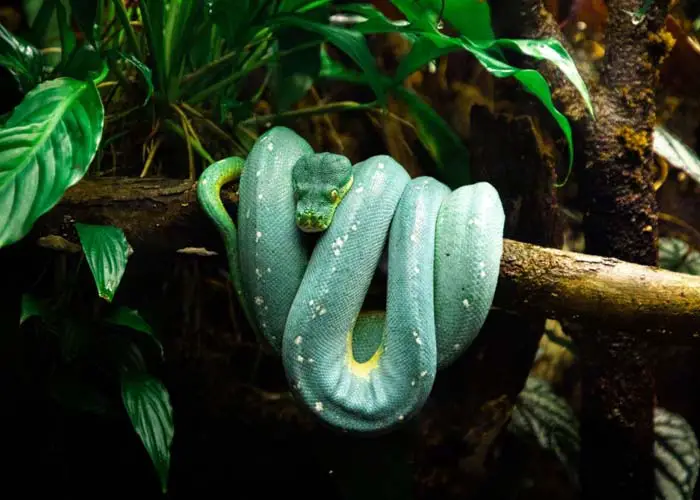
Green tree pythons are arboreal snakes. This means they live most of their lives in the trees.
Their enclosure should have “branches” or sturdy perches that crisscross the length of the enclosure.
These can be from the floor or in the upper two-thirds of the enclosure.
Your snake will weigh anywhere between 2 and 5 pounds, so the perches need to be sturdy enough to support that weight.
Have some perches run vertically to allow the snake to exercise different muscles.
All perches must be safely fixed to the enclosure so no wobbling will happen. Wobbly perches will cause the snake to stress.
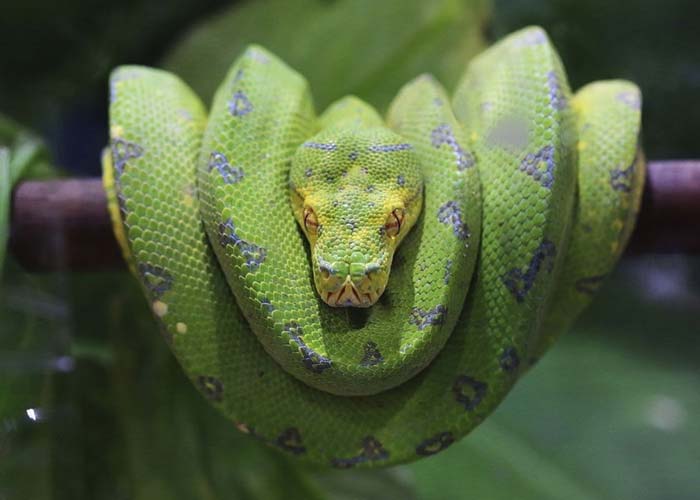
A green tree python does not usually coil around a branch to rest. Instead, it loops itself over the branch (creating U-shaped layers) and will rest its head in the middle.
Therefore, the perches you use must be thick enough for the snake to do this.
A good guide is at minimum the perches are the same girth as the snake.
Snakes need their hideaways for when they are feeling stressed or need a little privacy. Because the green tree python is arboreal, the hideaways need to be in the branches.
Hang silk plants or other greenery, that you can keep clean, on both the warm and cool sides of the terrarium. There should be enough coverage to provide the snake with a sense of security.
Substrate for a Green Tree Python’s Enclosure
A substrate is the stuff at the bottom of the enclosure. There is no need to be fancy; newspaper and paper towels will do perfectly. They are the cheaper option and far easier to clean. However, these do not hold moisture or heat well.
If you want to provide a more natural-looking and feeling environment for your snake then there are specific requirements.
Cypress mulch is a good bet as it holds moisture well. We recommend to use 100% Natural Zoo Med Cypress Mulch.
Pine shavings and other wood shavings like it are bad for snakes in general because they have oils in them that will irritate the snake’s skin and cause respiratory issues.
Move the substrate around daily and do a spot clean. A full enclosure clean should be done every couple of weeks.
We suggest that you have a removable perch that you can safely take the snake out with when cleaning.
Transfer the snake to another display or a dark and quiet place to avoid stressing it.
As this snake is more for display than it is for handling you could go the “whole-hog” and create a natural environment with real plant life and natural drainage systems. This is a time, labor, and financially challenging route but well worth it.
Lighting for a Green Tree Python
Your python does not require special lights, however, special lighting can bring out different hues in its coloring and has added health benefits.

Using a combination heat lamp that has full-spectrum lighting is an efficient way of providing these benefits for your snake, but it’s not necessary.
Green tree pythons do require a 12/12 light cycle, they need at minimum 10 hours of darkness at night. It is a good idea to have your light on a timer to avoid mistakes as this will confuse your snake and cause it stress. Our recommendation is Zilla Digital Timer.
These snakes are nocturnal animals. This means they will spend most of the day sleeping and resting and will be active at night.
Having a dark period is essential for the health of the snake. If your snake is in a room that receives light during their dark hours, have a way to effectively cover the enclosure and provide darkness.
Temperature for a Green Tree Python
As these snakes are arboreal, having a heat source only on the floor is not enough. We suggest having a heating panel on one side that overlaps part of the top of the enclosure. This will create a horizontal temperature gradient.
A heating source that does not emit any light is best so that the snake’s light cycle is not disturbed.
Our recommendation is VIVOSUN Reptile Heating Pad with Digital Thermostat.
VIVOSUN Reptile Heating Pad with Digital Thermostat
We suggest using a heat source that is controlled by a thermostat so that you have the most control over your snake’s temperature gradient.
If you use a heat bulb then you must have a suitable covering for it. The snake will climb and can burn itself on the bare bulb. If you are using your heat lamp inside terrarium, we recommend to use mesh cover, for example Vipe Heater Guard.
Basking Area
The basking area is the hottest part of the enclosure. It should be at 90°F and no higher. This spot is either right next to the heating panel or under the heat lamp. A thermometer should be located where the snake will bask.
You must provide decent coverage in the basking spot so that the snake can bask in privacy and without being disturbed or stressed.
Warm Side
The warm side of the enclosure should sit at 84-88°F. The snake should have a covered spot in this range, ideally where the temperature is at 84°F.
Remember that The green tree python is nocturnal. It will spend most of the day in one comfortable spot. Ensure that the perches located at 84°F are sturdy.
A thermometer should be placed on the warm side of the cage to monitor the temperature. If the snake is getting too hot it will regurgitate its food.
Cool Side
The coolest side of the enclosure should be 78°F, it can drop to 72°F at night. Your snake needs some coverage on the cool side of the cage too.
A thermometer needs to be placed on this side of the enclosure to monitor how cold your snake is getting. If your snake is getting too cold, it will be lethargic and sluggish.
Humidity for a Green Tree Python
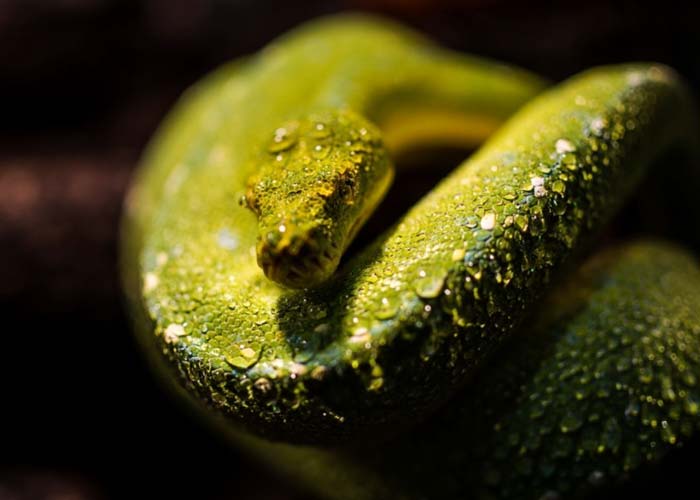
The humidity in the enclosure refers to the amount of water in the air. These snakes come from the rainforest where it is quite humid due to all the vegetation.
Your snake’s enclosure should have a humidity level of 70%. You measure this with a hygrometer placed in the middle of the enclosure. Our recommendation is Zoo Med Labs Digital Hygrometer & Thermometer.
There are a couple of things that you can do to ensure your snake has the right humidity levels:
- Have a large water bowl at the base of the cage.
- Have live vegetation in the enclosure. Research the vegetation first, you do not want a plant in the enclosure that will cause your snake harm.
- Spray your enclosure in the morning (4-5 sprays) with a misting bottle. Do not mist your snake directly. This can provoke a defensive response.
- Use terrarium humidifier/fogger. If you want to have a more professional, our recommendation is REPTI ZOO Reptile Mister, it’s adjustable rainfall system. If not, you can check a simple but time tested Humidifier by Evergreen Pet Supplies.
Do not soak the enclosure or substrate. This can encourage mold to grow which will cause respiratory problems for your snake.
The Right Diet for Green Tree Pythons

Water
A large enough water bowl needs to be at the base of the enclosure. It must be water-tight to prevent over-saturation of the substrate. It needs to be big enough so the snake can lie in the water when it comes up to shedding time.
Food
Green tree pythons are nocturnal; therefore, their ideal feeding time is around dusk. They can become slightly more aggressive during this time so feed with caution.
These snakes have heat-sensing pits along their snout. Your hand and their food both register with heat signatures so feeding with tongs is recommended.
unlumm Feeding Tongs 15″ 2 Pcs
Remember, green tree python teeth can cause serious damage.

Do not handle your snake 24-48 hours before feeding, while they are feeding, or after feeding. This will cause the snake stress and it can regurgitate its food.
We do not recommend live prey as there are risks to your snake. Frozen prey thawed in hot water is perfect. Feed the thawed prey to the snake while it is warm (not hot) and wet.
- Hatchlings: Feed every 7 days
- Juveniles: Feed every 10 days
- Adults: Feed every 14 days (or feed smaller meals every 7 days)
These snakes hunt in the wild using their caudal lure to lure food to them. They eat rodents, tree lizards, and birds.
A rule of thumb to guide food size for your snake is that the prey’s girth (thickest part of the body) should not be larger than the girth of your snake (thickest part of the body of the snake, not the head).
Handling of a Green Tree Python

Neonates should not be handled at all as they are incredibly fragile.
These snakes are not for frequent handling. They are rather for display. Certain breeding lines, such as the Biak, can become aggressive if handled too much and will snap at the handler.
Obviously, some handling will need to happen. Starting with a subadult is best as they can get used to you over a long period of time.
Consistency is key:
- Maintain a handling schedule of twice a week
- Wear a thick glove to give you confidence
- Open the cage and slowly remove the perch that the snake is on. Let it rest on your arm
- Never bring the snake near your neck or face. Remember, 100+ super sharp teeth
- After being out of the enclosure for a bit (slowly increase this over time) gently return the snake to its enclosure
Monitor your snake. If it does not like being handled so frequently, then do not handle it more than necessary. Never handle a shedding snake, they can be aggressive and snappy.
Potential Health Issues of a Green Tree Python
Buying snakes from the illegal pet trade increases your chances of getting a snake that is malnourished, has parasites, or is so stressed and traumatized that it will die within a year or two.
However, even captive-bred snakes have issues. Mismanagement of the snake and insufficient enclosure control will lead to a variety of fatal health issues:
- Over-feeding your snake will lead to obesity. A “fat” snake is not a funny snake. Obesity leads to multiple organ failure.
- Over-heating your enclosure will lead to pathological wasting of your snake as they will constantly regurgitate their food.
- Respiratory problems will occur if the enclosure is left to get moldy or is too humid.
- Dry skin and an inability to shed are caused by too low humidity levels.
Breeding the Green Tree Python

Remember that breeding for specific morphs is unpredictable. It is made even more difficult by infertility caused by inbreeding.
Prime sexual maturity is reached at three years old for males and females. Both snakes need to be a healthy weight, slightly increasing feeding just before attempting breeding is a good idea, so they have some extra fat stores.
Reproduction usually happens between August and December. Both females and males need to go through a few weeks of temperature cycling. Lower the temperature at night to 68°F and maintain normal day time temperatures.
Once a male is introduced to the female (remember that they are nocturnal so do this in their active window) they will breed if they are compatible. This will happen repeatedly over a couple of days.

You will know the female is ovulating when she stops eating and has localized swelling. She will do a pre-laying shed two to three weeks before she lays her clutch. Remove the male and return the heat settings to normal.
Once the female has laid her clutch (8-25 eggs), she will coil around them to incubate them. In the wild, females will look for tree hollows to lay their eggs.
Try to mimic this by providing a partially covered wooden box on the ground for the female to lay her eggs in and feel safe. You can remove the eggs and incubate them at 87°F if you want.
Conclusion
If cared for properly, the green tree python (a.k.a Chondro) is a hardy snake that will live a long life.
Green tree python teeth can do serious damage, so remember that they are not the snake for cuddles, but they are truly beautiful specimens.
Source your python from a reliable captive breeder, care for it well and it will be a rewarding experience. We “herp” you have a successful journey owning your green tree python!
Related:

